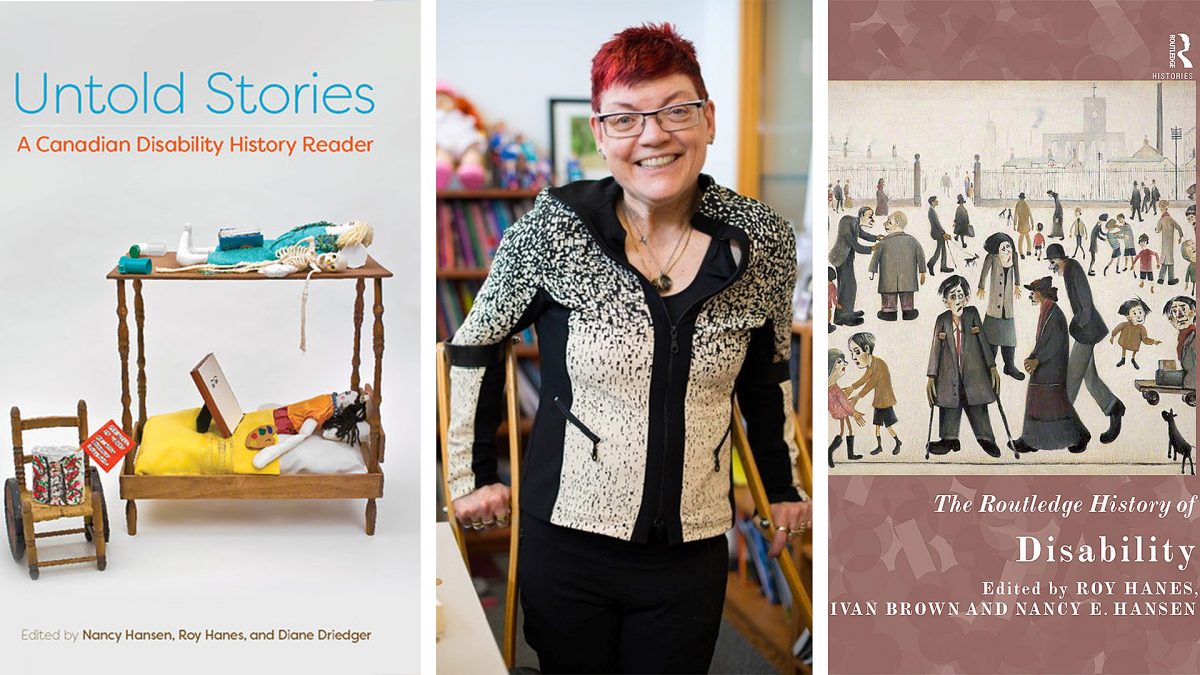
Associate Prof. Nancy Hansen has co-edited two books—Untold Stories: A Canadian Disability History Reader, and The Routledge History of Disability.
Completing the picture of human history
In history, Nancy Hansen found both problems and solutions.
Within her first year of working at the University of Manitoba, Hansen joined a team of 13 other disabled academics to study from a disabled-person’s perspective, Nazi Germany’s policy of eugenics, which led to segregation, institutionalization, sterilization, and mass murder.
From the horrors of this dark chapter, Hansen resolved that “never again” for her meant she needed to retell history from a disability perspective. In doing so, she sought to influence public attitudes and opinions—and consequently public policy—by “regularizing” the presence of disability in everyday life.
“It’s about putting disability back into the historical landscape by increasing its visibility and recognizing that our history is richer because of disability,” Hansen said. “Disability is rich and textured and important.”
Now associate professor in the University of Manitoba’s interdisciplinary master’s program in disability studies, Hansen has co-edited two books—Untold Stories: A Canadian Disability History Reader, and The Routledge History of Disability, the latter having been recently released in paperback format.
“Disability is creativity at a moment’s notice. It adds depth and texture. It’s another element in the human experience. We’re completing the picture.”
Released in May 2018, the Canadian history documents how persons lived and worked with disabilities in its many forms—mental, physical, and cognitive. The book also addresses the ways public policy in Canada was shaped by persons living with disabilities—many of whom were from Winnipeg.
‘Cradle of the disability rights movement’
“Winnipeg is the cradle of the disability rights movement in Canada, full stop,” she said, noting that people like Jim Derksen, Henry Enns, Allan Simpson, George Dyck, Yvonne Peters, and Doreen Demas were instrumental in the development and passing of equality and disability rights provisions in the Canadian Charter of Rights and Freedoms, the UN convention on the rights of disabled people, as well as the Accessibility for Manitobans Act.
The second book released in 2017, broadens the historical scope and perspective to tell the story of disabled persons worldwide, encompassing antiquity to the 21st century.In researching the books, Hansen found that historical figures with disabilities were subject to editing.
“Historically represented individuals have had disability as a part of their experience. But traditionally, we’ve been subject to historical erasure,” Hansen said. “Because it would seem that if that disability is recognized that somehow the accomplishment is diminished.”
Traditionally, the topic of disability has been approached in Western-European literature as a one-dimensional, medicalized understanding that sees disability as a deficit. However, Hansen’s history texts expand the story to include inter-sectional approaches that cross paths with other social spheres, including racial, ethnic, religious, cultural, sexual, gender and class divides.
“It’s important to recognize that we’re not just one thing, Hansen said. “We have rich, vital lives and we’re working toward social justice.”
By framing disability as a natural part of the human condition, Hansen is excited about a future where society seeks to embrace the largely untapped into the potential of a population that represents 1 billion people worldwide, 20 per cent of the Canadian population and one-in-six Manitobans.
“Disability is creativity at a moment’s notice. It adds depth and texture. It’s another element in the human experience,” Hansen said. “We’re completing the picture.”
Click the links, if you are interested in purchasing Hansen’s books, Untold Stories: A Canadian Disability History Reader, and The Routledge History of Disability.






